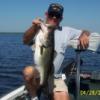There is lot of chatter on the internet about Stick Marsh/Farm 13, however very little talks about where it is and what it's function is.
This 6700 acre lake is one of four lakes that make up the headwaters of the St Johns River. In addition to these lakes is a large marsh, (Ft Drum Marsh), that all flow northward. Or the four lakes, Blue Cypress Lake is a natural, with the other three, Ansin/Garcia, Stick Marsh/Farm 13, and Kenansville, all being man-made.
The first function in the development of the three man-made lakes was and is to clean up the runoff of fertilizer and such from the surrounding farms and ranches. The second function of importance is to supply irrigation waters for these farms and ranches, and the last and of lowest consideration is to supply a recreation area for fishermen.
For Fish and Game and the state of Florida, unlike St Johns Water Management, fishing on these lakes is of major importance. As some of the finest fishing in N. America, these lakes provide tremendous source of tourism income.
The Stick Marsh/Farm 13, although it has two names is actually one lake. Most arrive here expecting something quite different because of the name, and are quite amazed when they view the 6700 acres. The lake does have a partial divider levee, but this is to force water flow through more of the lake for clean-up, than it is to split the lake into two.
The names Stick Marsh and Farm 13 were derived from their names prior to flooding. Stick Marsh was locally known as such due to the densely wooded characteristics of this marsh, and Farm 13 was radish field known as Farm #13 of Fellsmere Farms.
The two sides are quite different, with the main fish attractants of the Stick Marsh side being dense submerged woody cover with just about no structure, and the farm side being a combination of both structure and cover.
Looking at the photo above you can readily see the submerged remnants of the irrigation ditches that were used to supply water to the Farm prior to flooding. These structure play a huge part in the summer patterns on this lake. Knowing the characteristics of these ditches will spell the difference between fishing success and failure for a significant part of the year.
On the south end of Farm 13 there is as much wood, if not more per square foot, than what can be found on the Stick Marsh side. Knowing these areas and the denseness of the wood is of extreme importance during the entire spawn cycle, which by the way takes place from December through May many years.
If you know the area, catching fish like the one below is very common.
This lady was one of over 75 caught this March of 09. As you can see, the lake was low and the wood very visible. However much of the time this extreme cover is hidden by high water levels and then migration routes and the knowledge of them becomes important. There are old roadbeds there and knowing them does make a big difference. This cover spreads across the south end of the lake but some is productive and some, well you get the picture.
The Stick Marsh side is wall to wall covered with wood. Again, as any lake, only some will hold fish however. Knowing where these areas are, and staying out here full time will make the difference in finding fish most times.
This 14.3-pound lady came from the Marsh side.
In the hurricanes that ripped through the area back in 2004, we as well as other lakes in south Florida, lost the hydrilla to severe wave action. To this date it has not recovered. However, that is a biological function and not the function of some mysterious spraying action as suggested by some. When there is spraying for hydrilla it must be done during a very narrow window in the month of April. As the source of irrigation for the Farm, if spraying were taking place, it would destroy not only hydrilla but also the crops of the farm being irrigated. Unlike the spray used for hyacinth, which is a contact spray, the spray used for hydrilla kills submerged vegetation and would kill anything the dilution was sprayed on. So it's not the spraying, and it's not aliens coming at night stealing the hydrilla, but rather a normal biological function that has the hydrilla missing.
Forage on this 11 square mile body of water is comprised of primarily wild shiner, and threadfin shad. With the lack of hydrilla, which provided a place to hide for the forage, they are constantly on the move. As they move, so moves the bass, and keeping up with this movement is a daily, and sometimes even hourly chore.
However, from the map above, and some of what I have covered here, your trip will be more productive next time you are here.















